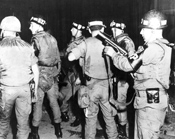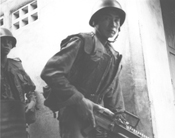- Exhibits
- Tet Offensive
- Saigon
The Tet Offensive (Tết Mậu Thân)
- The Tet Offensive (Tết Mậu Thân)
- Hue: The Imperial City
- The Battle of Khe Sanh
- The Battle for Saigon
- Aftermath of the BattlesPolitical ConsequencesExhibit Credits
The Battle for Saigon

AVSG-S-1031-31/AGA68 RVN Saigon Military police from the 716th and 527th MP Bn., take their positions across the street from the U.S. Embassy. 31 Jan. 1968 Photo by: SP5 Edgar Price Pictorial A.V. Plt. 69th Sig. Bn. (A)
(Donald Jellema Collection (Department of the Army Special Photographic Office (DASPO)) [va030808])
Vietnamese paratroopers cautiously move down alleyway as they advance on Viet Cong positions routing the enemy in the Phu Nhuan section of the capital city. The fierce battle ensued as the Viet Cong attacked during the early morning hours of January 31, 1968, the festive TET holiday period for the Vietnamese people.
(Douglas Pike Photograph Collection [va000406])In 1967, the North Vietnamese planned an ambitious offensive designed to take advantage of the Tet truce of 1968 and completely overwhelm their enemy in a series of lightning attacks across South Vietnam. Saigon was a prize that the North Vietnamese wanted badly, figuring the occupation of the South Vietnamese capital would go a long way toward ensuring a communist victory. The offensive began in late 1967 with a series of battles along the Cambodian/Laotian borders designed to draw American troops away from the cities.
The thing I’ll never forget is coming out of Ly Khe you hit a ridge and you kind of go down in the valley. We hit that ridge and it was like dusk. It was still the sun had gone down but still sunset in the sky and everything. Everywhere you looked there were helicopters. I mean, it looked like every chopper in Vietnam was in the air and there was all this fire going on from these choppers down at various places and stuff, and my track was in the middle of this column and all I could see in front of me was tanks and tracks and all I could see behind me was tanks and tracks, the whole squadron.
- James Holt [Oral History # OH0195], Transcript page 24 lines 17 – 24.
(complete interview; transcript; more information)In Saigon the South Vietnamese government had requested that ARVN troops be put in charge of the city’s defense, and on 15 December Gen. William Westmoreland complied by withdrawing all American fighting units from the city. During the Tet holiday the only troops in the city were 1,100 American MPs under the command of Brig. Gen. Albin F. Irzyk, commander of Headquarters Area Command (HAC), and the ARVN units, which were mostly at half strength due to leave granted for the holiday. To take advantage of this vulnerability, the North Vietnamese planned a set of attacks designed to take and hold key Saigon facilities with the goal of eventually capturing the whole city. For weeks they sent soldiers into Saigon disguised as Tet celebrants or tourists and smuggled weapons into the city hidden in trucks full of produce and Tet supplies or in coffins in fake funeral processions, everything poised to be ready for 31 January.
The communists ran into several problems. First, news of the offensive reached Lt. Gen. Fred Weyand, Commander of II Field Force, in early January. He urged Westmoreland to cancel the Tet leave, heighten the alert status across the country and, more importantly, move some units away from the border battles and back to the cities. Second, the MPs in Saigon transformed themselves into combat infantrymen during the initial Tet assaults, while the ARVN units, despite their low strength, performed admirably holding their own against the communist troops.
Read More:- The Viet Cong in Saigon: Tactics and Objectives During the Tet Offensive By Victoria Pohle (88 pages) [January 1969] - 1070412001(see full record)
- Article: "The Defense of Saigon" The Reporter (by: Denis Warner) (6 pages) [04 April 1968] - 2131110007
(see full record) - ARMY 1968 25TH INF DIV TET AAR (105 pages) - 168300010351
(see full record) - CHECO Reports # ; The Defense of Saigon Nov 1967 - Aug 1968 ; 14 Dec 1968 (108 pages) [14 December 1968] - 0390135001(see full record)
Vietnam Center & Sam Johnson Vietnam Archive
-
Address
Texas Tech University, Box 41041, Lubbock, TX 79409 -
Phone
(806)742-9010 -
Email
vnca@ttu.edu

